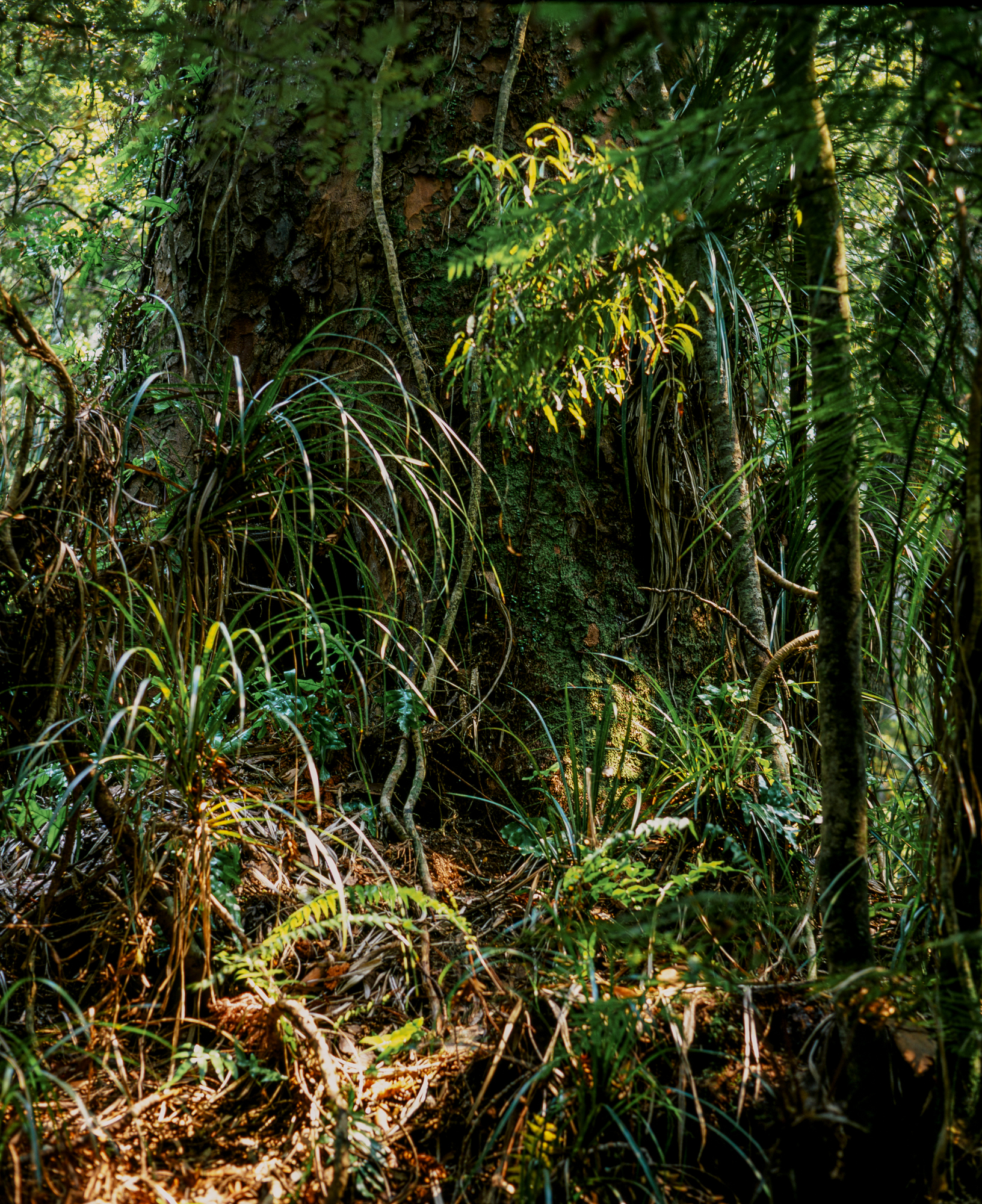
Wildlife in Ngahere
Eating as a Māori: An incomplete guide to an edible bush
Māori ways of interacting with and extracting resources from the ngahere have changed since Charlie Dunn was a boy running home from school and into the bush for theseason’s first berry harvest. When we spoke he mourned the recent loss of contact with the bush. Regarding the karaka berry, a common bush treat, he lamented, “Everybody used to eat it when we were kids. But now you can go and buy roasted peanuts or go to Pak‘nSave and buy chocolate peanuts, so why would you?” As for experiencing the bush, “We are just getting too lazy now to go in,” he said.
Of the ways Māori retain their connection to the ngahere, unting and gathering are high on the list. Charlie was ripe with advice about the edible side of the bush, so, in an ode to food’s integral role in connecting people, wildlife and the landscape, I present Eating as a Māori: an incomplete guide to an edible bush.
Like all of the information shared through this project, this chapter is not meant as a comprehensive record of Māori cuisine and customs. Rather, it is a bundle of advice and anecdotes that I received and mean only to pass on, hopefully in a way that it may reach an actual collector of Māori cuisine and customs, who may not know these particular preparatory preferences.
Hunting
As a young man, Manuel Dunn carried his butcher’s knife while out hunting pigeons. Occasionally, he would carve his initials into trees on his route, sometimes adding an arrow pointing in the direction the pigeons preferred to congregate. From his own trips in the bush, Charlie came to know the trees that marked his father’s path. Similar to Manuel, Charlie’s understanding of the bush can be measured through food.
“My mom’s brother used to be the ranger here for years. He was a bushman,” Charlie said, referring to Warawara. “He showed me how to eat worms if it came to the worst, ground worms. Huhu bugs. I’ve eaten grub worms just to try them. Roast them, put them on the fire, or eat them raw, open them up and squeeze all the inside out of them– which is all mud and dirt. Huhu bugs, they may be called silkworms, they’re white. You find them in rotten logs. You break open the logs and you’ll find them. They are the size of cicadas,” he said, holding up his fingers to approximate their size. “I haven’t eaten them raw to tell you the truth, but I’ve eaten them cooked. My dad used to eat them raw, but cooked they are beautiful. They taste like cashew nuts, when you roast them. They are beautiful, it’s just the look of them that puts people off. Like a big maggot, oily.”
Charlie has never been lost in the bush long enough to need to forage for his dinner, but he has had opportunities to test out the old ways of eating in the ngahere. While his grandfather worked out on the farm, he shared, “us kids used to take him his dinner and tea and he would break open an old log with all of these bugs in it and he’d cook them over the fireplace and we’d eat them. It was beautiful.”
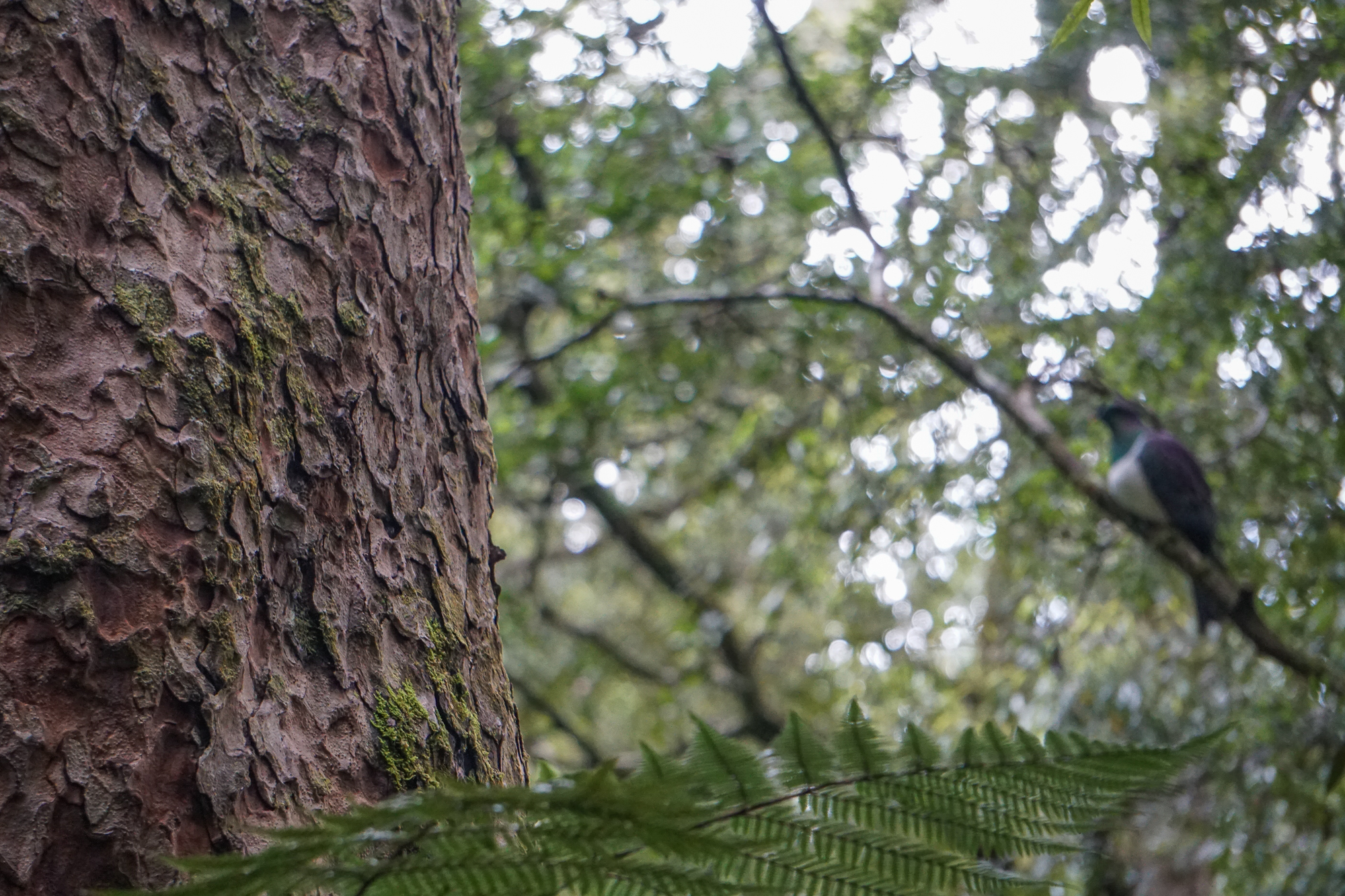
Māori have always hunted pigeons in the bush, though shooting wild native fauna is illegal in New Zealand. Today, wild pigs and cattle (both introduced species that are quite a nuisance) are the usual catch for hunters, but if a wild pigeon flew past an alert bushman, it’d likely be shot down and whipped up for that evenings’ dinner.
The Kererū or New Zealand pigeon is an iconic animal endemic to New Zealand. The bird, also known as kūkū or kukupa in Northland, is relatively large, averaging 51cm in length, and has a green head and white breast. Kererū are recognized for their distinctive noisy wingbeats and hold status as the only remaining New Zealand fowl capable of swallowing large fruit, which makes them an important seed disperser for native trees as well as a tasty full-bird dinner. I’ve been told that wild pigeons make a very nice meal, especially when they’ve recently eaten nettle berry. The flavor of the bird has not been identified as anything more specific than “beautiful” to me so, having never consumed a cooked kererū, I trust that the flavor is unique to the native bird. According to Charlie Dunn, “the taste goes through the whole bird, and the smell, you walk inside and you just want to feed straight away from just the smell of it. Coke and fries got nothing on that.”
As Hugh and I nursed our second cups of tea, Charlie described how to prepare and eat kererū. “You don’t eat it with anything, you just boil it. Boiled with a bit of salt, that’s all. I know a lot of people back when we were kids they would roast it and all of the flesh would go hard and it sort of kills the taste. Boiling it doesn’t do that. They didn’t even time it, you know, they’d go ‘the water’s hot’ and throw it in. You would open it up and it was still bloody and they’d eat it like that, they wouldn’t even take the stuffing out of it. It’s the only bird that when it eats the fruit, the fruit goes straight through them, they don’t digest it into shit. The berries go straight through the wild pigeons so you cook it with the innards still in them and all the fruit is still in there, and that taste just goes through the whole bird. It’s just amazing. I’m sure you guys would eat it if you smelt it. You’ve just got to smell it. That’s why there are no pigeons anymore. That’s why they are protected. Because everybody, the Māori and the white man, they all eat them. They aren’t safe from anybody, the wild pigeons. You know, the pigeon in town, they look just the same but they digest their food. But they are beautiful to eat,” he concluded, his mouth watering.
Since it is illegal to eat New Zealand natives, the wild pigeon dinner remains a covert celebration today. Though, dereliction hasn’t stopped Charlie from sneaking a taste of these illicit treasures. In fact, he has eaten a good chunk of the banned spectrum of New Zealand fare. “I’ve eaten the city pigeon,” he admitted. “I once had 24 here. I had a friend who lived in Whangārei who came here with them and gave them to me. I thought that he gave them to me to eat, which I did, they were fat and he had about 100 of them in Whangārei. One day, I came across him and he asked me how the pigeons were doing and so I told him and he started crying. He thought I would breed them. This guy was in his seventies or eighties. I was so ashamed of myself, but I thought he gave them to me for me to eat! You know, I reckoned they were old birds, fat birds, I brought them back and ate them. He wasn’t very happy. He passed away 8 or 9 years ago and I went down to his funeral. He’s got kids around the same age as me, and I told them what happened and they all cracked up. Also, I’ve eatean kiwi quite a few times. Pig dogs are a problem for kiwis. My uncle used to have a pig dog, but they had kiwis and so he had to get rid of the pig dog. He would get kiwis and he never ate them he would give them to me. They were beautiful, the kiwis, to eat. The only problem is that they are hard as old gum boots. You’ve got to really cook them to really get them good and soften them up. With the pigeons, you know, you just had to get the water warm and put the bird in and pull it out. With kiwis you’ve got to put it in a pot all night until the next day. Just slow cook it, it won’t soften up otherwise and it’ll taste like old gum boots,” he warned.
Gathering
The “old ways” of Māori living by the seasons didn’t seem so antiquated after Hugh and I listened to Charlie describe his childhood in Panguru. Living by the seasons was simple as long as you knew when the different trees were flowering and berry-ing up. In fact, it seemed that the complexities of a living ngahere can be illustrated, in part, by the web of life surrounding nīkau berries, the fruit of another native tree in Northland.
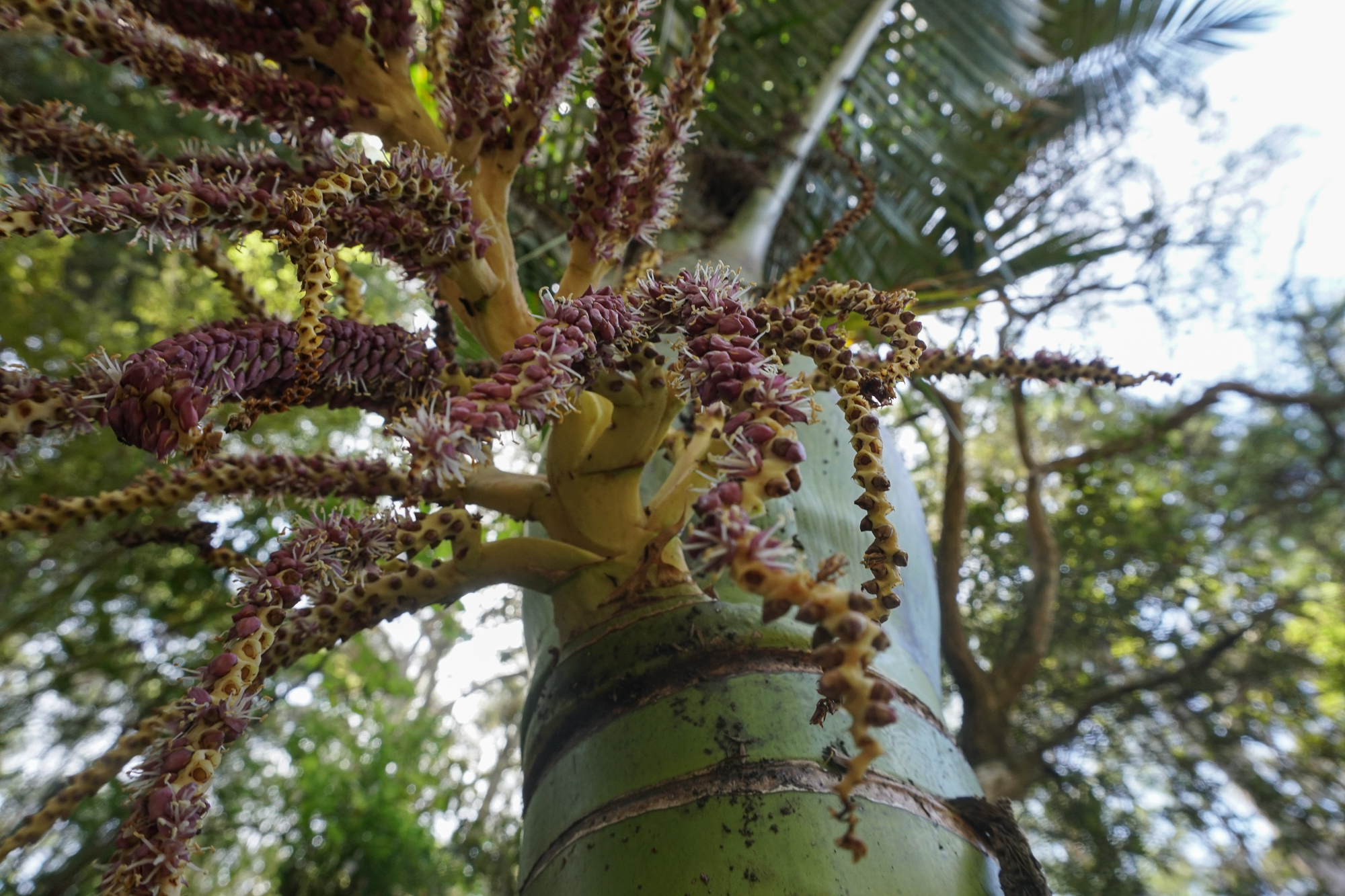
“Nīkau berries ripen and then the pigeons get to them. When they are working on them a lot of berries drop to the ground and the wild pigs get to them too. Us young fellows, we would go up here, which has a good nīkau patch, and that’s where the pigeons and pigs would be. Then we would cross the creek and come up to the top here and it was the same thing, nīkau berries are there too. If you go further in, there are the taraire berries. And further back you’ve got the nettle berries. But they were all different seasons too. When I say different seasons: these trees may fruit in March, and you think all those types of trees would fruit at the same time. The weather changes from one hill to the next and the sunlight reaches all day on one side of the hill and not at all for another and so the ones on the other side of the hill ripen late. It happens to all of the trees. Wherever the sun gets to first, those are the trees that ripen first,” Charlie explained. As he gestured toward the land beyond the kitchen windows, he added, “I live in wild pig heaven over here and pigeon heaven because it’s just straight over the creek. I could send one of my boys over there and they could come back within an hour with a pigeon. But, send him over the hill and he wouldn’t get anything. Same bush and everything but... It’s just where the fruits are ripening. The pigs know that, the birds know that, the rats know that, everything is...nature is so strong, eh? It’s just amazing.”
As an animal, human or other, you can eat most berries in the bush except for one. Tupākihi, or tup as Māori call it, are deadly poisonous and you can die within a couple of hours of eating them. “I’ve never tasted it but our parents tell us they taste bitter, I don’t know how they would know that but...deadly poisonous, not only to humans but to animals as well. I’ve known cows who got very sick from eating the leaves...” Charlie warned. “All the other berries in the bush you can eat. You’ve got taraire, miro, nīkau, hinau, cabbage tree...”
The nīkau have big palm leaves on them and a big bowl-shaped growth at the intersection of the foliage and trunk that holds the fruit. In order to eat the fruit of the nīkau you must open up the bulb. The inside of the bulb is a similar texture to the heart of a cabbage. They are good to eat, but people rarely try them today because cutting down the bulb kills the tree. On the rare occasion that you become the handler of a nīkau bulb, just remember, “it’s beautiful in salads.”
Karaka berries are another native treat. Their flesh is edible but the seed inside is toxic if consumed raw. After a few hours of preparation, though, the seed/nut is a satisfying morsel. You know, Charlie claimed, “I’d rather eat karaka berries than grapes. You eat the nut inside. You can eat the outside [of them] too, they aren’t poisonous. When they are ripe they are big yellow fruit, and the flesh is delicious, but you can’t eat the seed. That’s very toxic if you eat it raw.” To prepare them, “You’ve got to boil the seed for 2-6 hours, then you put it in a bag and put it in a running creek for a week to soak and clean all of the toxins out. All of the skin will come off the nut and they are beautiful to eat, they are one of the best ones to eat.”
Food links people to the land and the patterns of when and how people find and eat their food today may reflect the patterns of previous generations. The transfer of knowledge through experience is potent in Charlie’s recipes, passed down from his grandfather to him.
Species Profiles

Food is said to be part of the overall wellness of people, ergo everything is connected by it. Māori even observe that food heals as well as water or rongoā. As such, following food by way of indigenous flora and fauna reveals the diffuse networks that exist in an ecosystem like Northland. While not all wildlife in the ngahere is edible, many nonedible plants in kauri forests serve other functions. Māori have long identified indigenous flora and fauna for their uses in homemaking, weaponry and traditional crafts as well as their medicinal properties. As I spent time around the native kauri forests of Northland, these plants came up in conversation. In small doses, I was introduced to bits of mātauranga Māori or traditional knowledge in their region.
Mātauranga Māori regarding indigenous plants has gained credibility in modern scientific circles, but since Māori don’t pair their observations with data like scientists do, a comprehensive inclusion of indigenous knowledge into the Western lexicon may be far off. Typically, when Western practitioners show interest in properties of indigenous plants, they set out to quantify and describe the mechanism that causes the trait. Usually, Māori have long been aware of the attribute and so the findings merely describe the trait using different terminology. However, every so often, the merging of traditional knowledge with Western data births new information that may benefit both parties, and it is in that direction that New Zealand may be heading (more on that in chapters VII & VIII).
Bits of the natural remedies, traditional treatments and medicinal knowledge of rongoā Māori entered my investigation quite seamlessly by nature of how freely Māori reference the healing properties of their taonga species while discussing the ngahere. For in their worldview, the two are permanently linked. I learned which plants make proper burn poultices, that insect bites indicate that kawakawa leaves are at their most medicinally potent, how to use a kareao (supplejack) vine to catch tuna (eels), which natives grow symbiotically together, and how certain physical properties in a plant correspond to how that plant heals both the Earth and the human body. Still, I reiterate that rongoā knowledge has been accumulated by generations of healers who have observed how indigenous plants interact and grow and I warn that this text includes only informed fragments of that knowledge.
The coming Species Profiles display a selection of native wildlife and identify their unique uses and the exchange of reciprocity that occurs among them. These plants, all found in and around kauri forest areas, rely on one another to sustain a healthy ngahere. They are native to Aotearoa and participate in the responsive network of life diffuse throughout Northland.
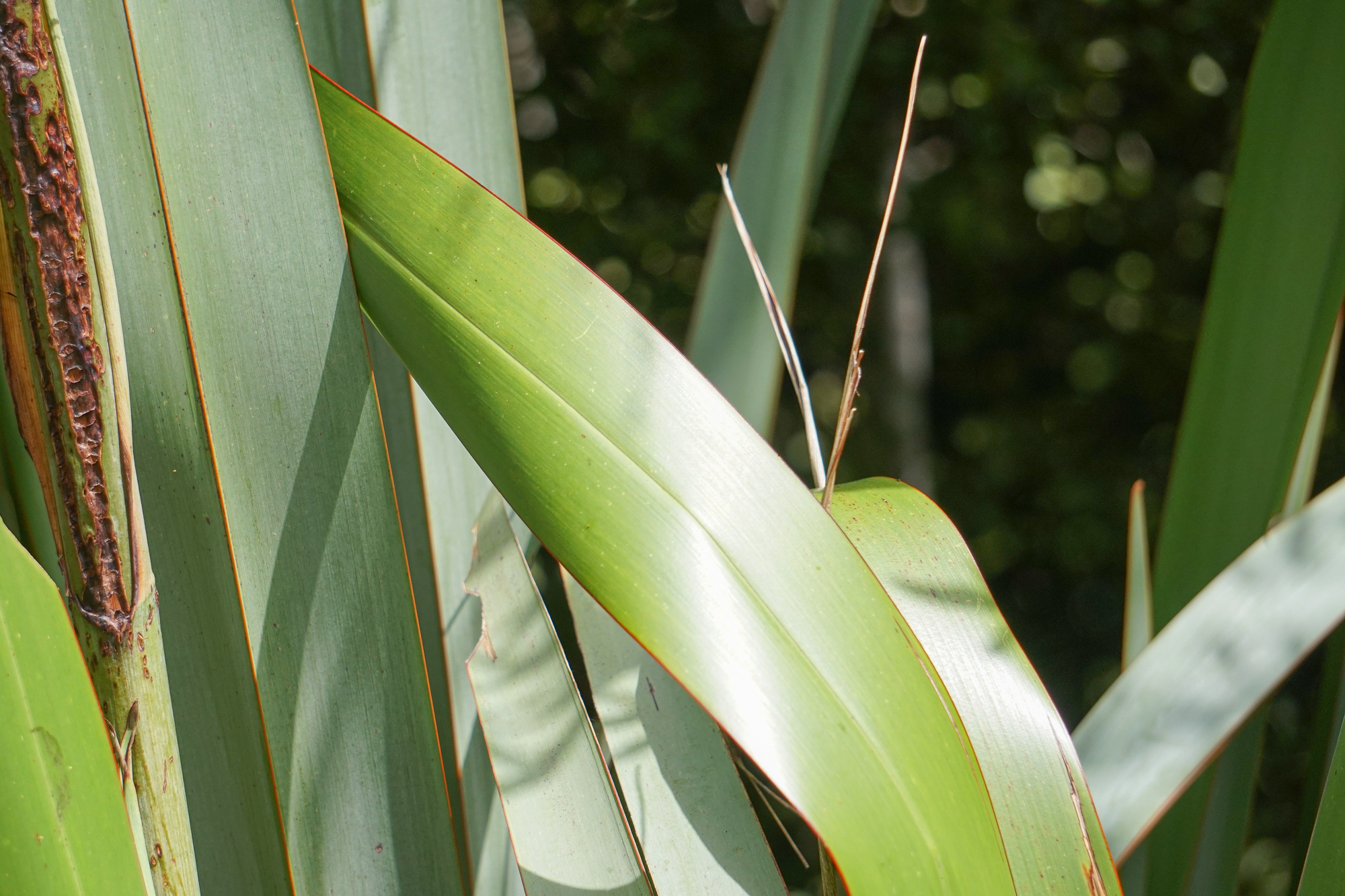
Stalks, Leaves, Stems, Roots, Gum
Harakeke or “New Zealand Flax” grows in warm areas and is prolific around Northland, making it a staple resource in early Māori life. Māori used the abundant plant as rope in their canoes, to wrap their food for hāngi (a traditional method of cooking using heated rocks buried in a pit oven, called an umu) alongside tea tree wood and sought it out for rongoā. They also used harakeke for weaving their kits, mats, baskets and skirts. In its scientific name, “Phormium'' means “basket or wicker work” and “tenax” means “holding fast,” referring to the strength of the fibers. In early days of trade and colonization, flax fiber was used for ropes on ships and traded by Māori, along with obsidian and greenstone, for alternative stones and weapons. Harakeke was introduced to Britain in the 19th century and soon replaced the weaker European flax fiber in twine and rope. New Zealand had a thriving flax fiber industry until flax yellow leaf disease led to its downfall in the 1950’s, but flax is still grown commercially in Britain today. In addition to populating native forests, harakeke grows naturally alongside most of the roads and farmland across Northland and is included in eco-nursery inventories to be planted alongside other natives.
There are many known medicinal properties of harakeke. Murdoch Riley’s book Māori Healing Remedies: Rongoā Māori includes treatments that utilize the Stalks, Leaves, Stems, Roots and Gum of the plant. See: Arthritis (7), Boils and Abscesses (13), Burns and Scalds (18), Chilblains (23), Constipation (27), Lactation (47), Menstruation (49), Rheumatism (55), Ringworm (57), Skin Complaints (59), Worms (73) and Wounds (75).24 Murdoch Riley, Māori Healing Remedies: Rongoā Māori, 7, 13, 18, 23, 27, 47, 49, 55, 57, 59, 73, 75.
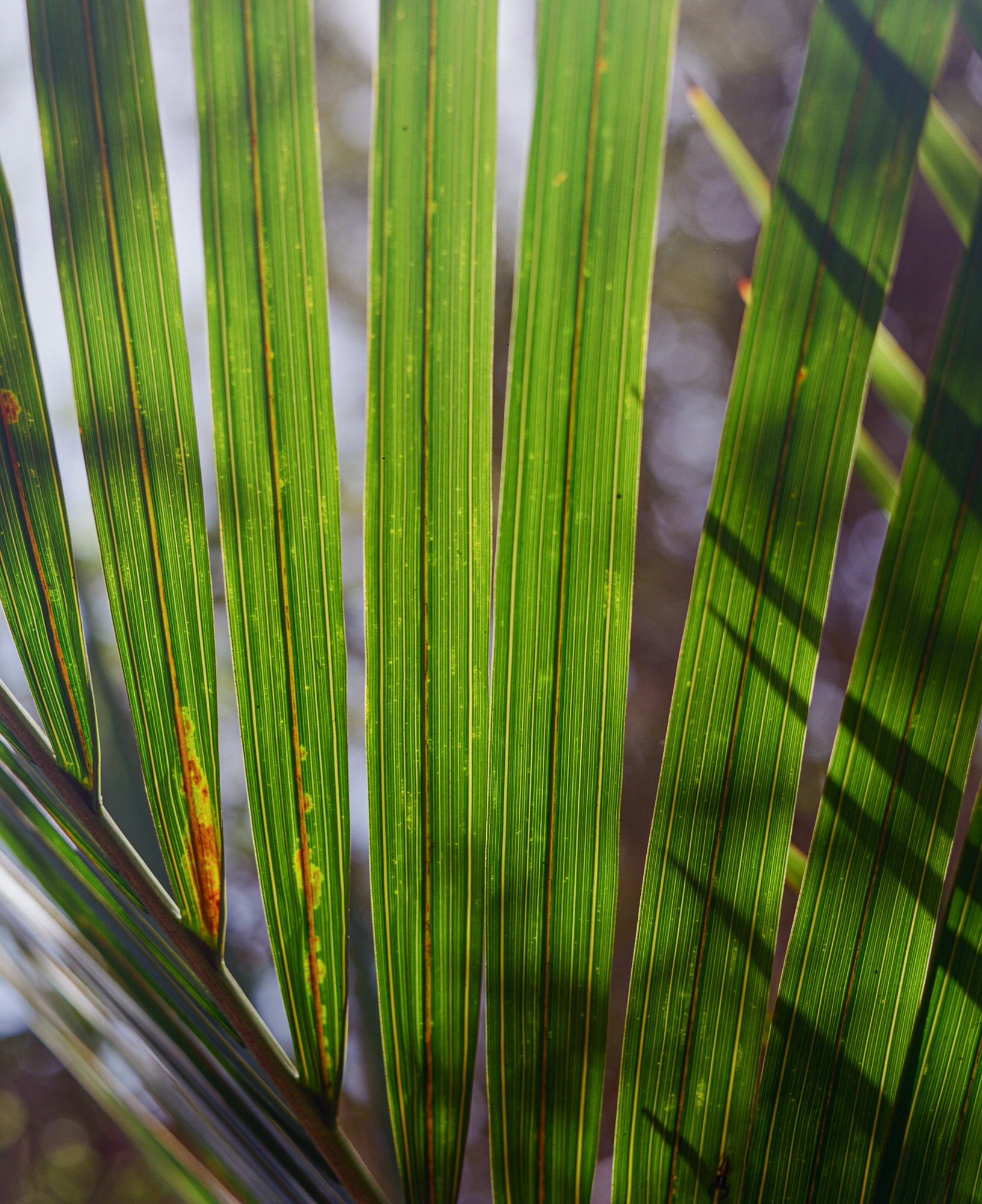
Leaves
Nīkau or “Nīkau Palm” is a native tree with a slim, straight trunk and large palm-like branches. It has a bulb at the intersection of its trunk and foliage that fruits seasonally. As Charlie mentioned in Eating as a Māori, the seasonal fruiting of nīkau berries benefits many creatures in the forest, from pigeons to pigs to humans. However, it’s the nīkau palm leaves that are the primary resource for rongoā healing. In the past, dried nīkau leaves were used as splints for broken limbs.
Murdoch Riley’s book Māori Healing Remedies: Rongoā Māori offers one treatment that utilizes the Leaves of nīkau. See: Sprains and Fractures (65).25 Riley, 65.
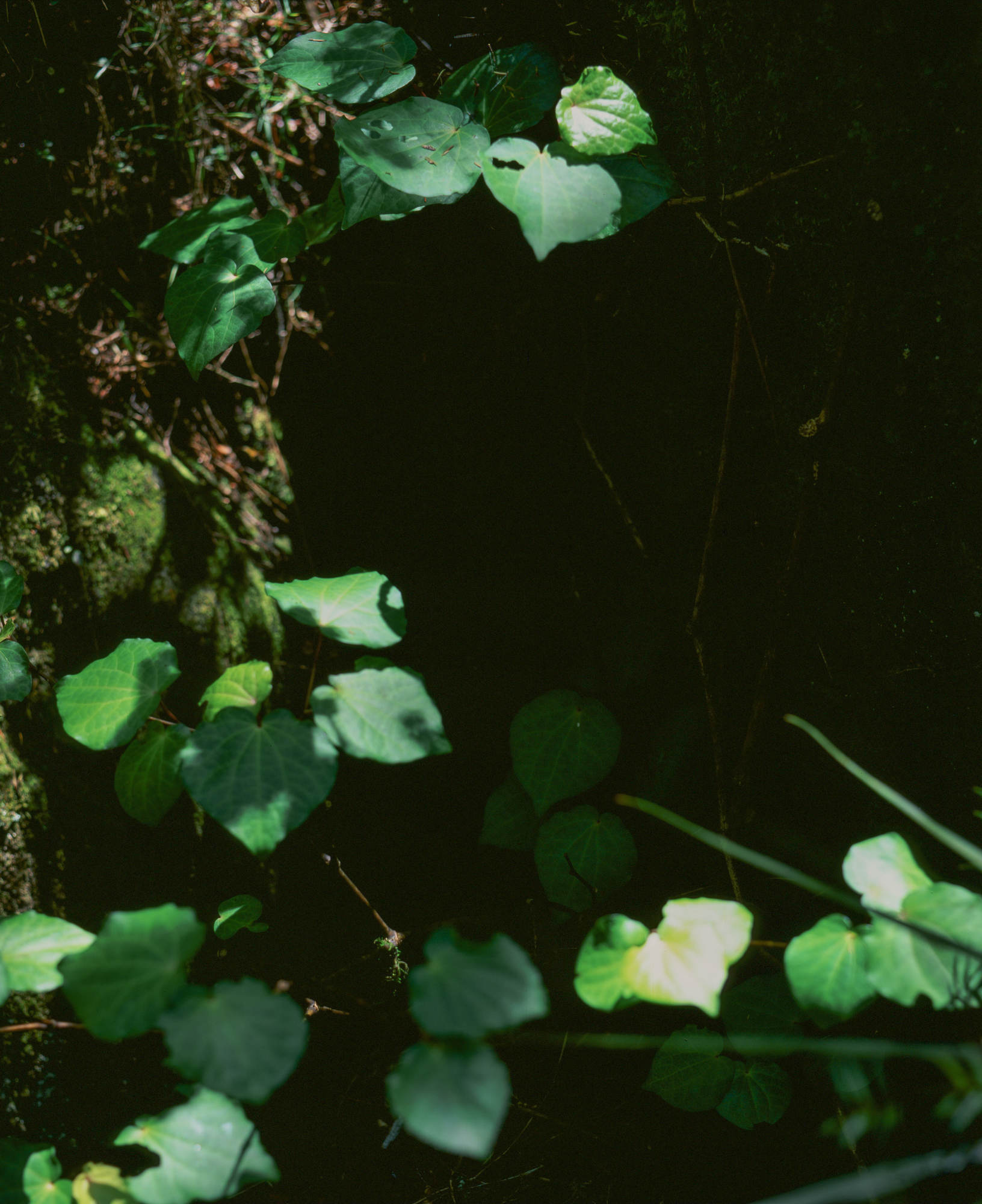
Leaves, Fruit, Seeds, Twigs, Bark/Wood
Kawakawa or “Pepper Tree” is common in kauri forests and serves a unique function in the ecosystem. After the plant fruits, its heart-shaped leaves turn yellow as insects begin to eat away holes, indicating they are ripe for picking. Once harvested, kawakawa leaves may be boiled into a medicinal tea or made into a poultice to heal burns or cuts. For the poultices, said Kevin Prime, “Get a match and burn the leaf and you can see the oils coming out and then you press it on the wound for 10 seconds and then bury it in the leaves and then you get another one, do the same and leave it on and forget about it until it falls off– in a matter of hours it’s already starting to heal, the blood stops.”
While Māori have long understood the medicinal properties of kawakawa, the subtlety and symbiosis between the plant, insect and human was only quantified once Western scientific knowledge assessed the relationship. Kelly Kahukiwa explained that during the time period after kawakawa fruits, when the insects begin to feed, the plant excretes a chemical deterrent to protect its leaves from the insects. The chemical cocktail is what provides the health and healing benefits of kawakawa and the leaves most ravaged by insect bites contain the highest concentration of medicine. On top of that, the holes caused by insects allow sunlight to reach the leaves lower down on the stalk, helping the plant grow stronger and survive until the next harvest. Native plants perform the same duties for the Earth as they do for humans, and Māori have learned what those abilities are through generations of observation. Modern science may have exposed the inner mechanisms that produce the rongoā properties of kawakawa and other natives but only after Māori first identified which properties were significant.
Murdoch Riley’s book Māori Healing Remedies: Rongoā Māori includes treatments that utilize the Leaves, Fruit, Seeds, Twigs and Bark/Wood of kawakawa. See: Arthritis (7), Asthma (9), Bad Breath (11), Boils and Abscesses (13), Bronchitis (15), Colds & Coughs (25), Constipation (27), Insect Bites (37), Kidney/Gallstone/Bladder Problems (45), Painkillers (53), Toothache (67) and Warts (69).26 Riley, 7, 9, 11, 13, 15, 25, 27, 37, 45, 53, 67, 69.
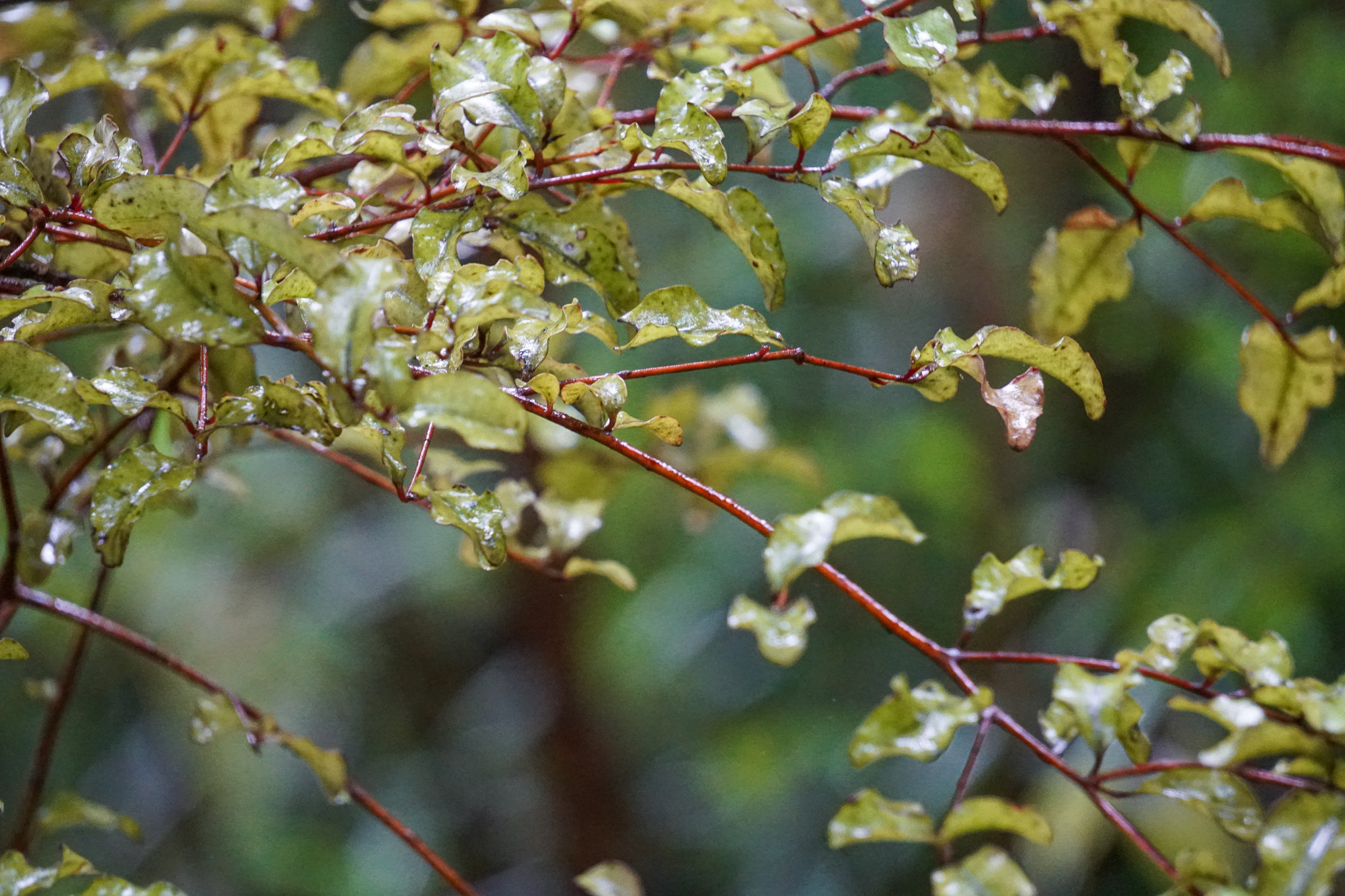
Leaves, Bark
Māpou or “Red Matipo” is a species of shrub in the Myrsinaceae family endemic to New Zealand, found both on mainland and offshore islands. Like other native plants, Māori believe that whatever red matipo does for the Earth, it does for the human body. The red tint of its branches signifies it is good for the blood flow in our veins, it acts as a purifier. According to the indigenous mindset, if there is a disease spreading through the soil, then the soil needs cleansing. Therefore, red matipo growing nearby infected or at-risk areas will cleanse and purify the soil. Māori who have observed this phenomena maintain that where red matipo grows, especially alongside kawakawa, Kauri Dieback Disease is suppressed. Inspired by this aspect of mātauranga Māori, scientists have been exposing early stages of the phytophthora to different native plant roots, including kawakawa and red matipo, to identify what attracts it and repels it. Early tests indicate that the phytophthora spores (the mobile stage of the pathogen) explode when they come in contact with the root water of kawakawa. Kelly, speaking from the mātauranga Māori point of view, suggests that they plant both red matipo and kawakawa in variation in areas they are trying to protect from Kauri Dieback Disease.
Murdoch Riley’s book Māori Healing Remedies: Rongoā Māori offers one treatment that utilizes the Leaves and Bark of red matipo. See: Toothache (67).27 Riley, 67.

& White Manuka / Kanuka (Kunzea ericoides)
Berries, Leaves, Shoots, Bark (Out/Inside)
Kahikātoa, known by Pākehā as manuka, is commonly referred to as “tea tree” by people in New Zealand. Kahikātoa has rough red wood on its trunk and short spiky foliage. It blossoms seasonally into white or red flowers, depending on the species, and the flowers contain antibacterial properties which Māori use in their medicines and, more recently, in honey and skincare products. Early settlers discovered that when steeped in hot water, the leaves of this native tree boiled down to a nice substitute for tea, and so they nicknamed the plant “tea tree.”
The New Zealand government recognizes the plant’s antibacterial properties and measures them with a UMF (Unique Manuka Factor) designation. As the honey industry expanded beyond Northland, to other parts of New Zealand and eventually abroad, the government revised their standards to narrow the scope of high-grade honey. The new UMF standard distinguishes between mono floral and multi floral grade in an effort to squelch opportunities for plagiarism in the international market.
Māori have always recognized the ecosystem services that tea trees offer beyond producing honey. In early days, Māori used tea tree wood to build bed frames and structures in their pā sites, to separate their food while cooking hāngi, and they would also brew the leaves of kahikātoa into a medicinal tonic to treat ailments. Today, Māori plant tea trees as a buffer around waterways and as a nurse crop. Tea tree shrubland is the first stage of growth in native forest regeneration and is planted by landowners like Kevin Prime in an effort to reestablish natives in Northland. It takes around 30 years for tea trees to mature, at which point the early stages of native growth have already occurred, laying the groundwork for new plots of native forest.
Murdoch Riley’s book Māori Healing Remedies: Rongoā Māori includes treatments that utilize the Berries, Leaves, Shoots and Bark of tea tree. See: Bad Breath (11), Constipation (28), Diarrhea (31), Influenza (35), Itch Relief (41), Oral Thrush (51), Rheumatism (55), Sore Throat (63).28 Riley, 11, 28, 31, 35, 41, 51, 55, 63.

Leaves, Fruit, Young Shoots
Kumarahou is a shrub-like plant endemic to the Northern region of Northland that blooms abundant yellow flowers in the springtime. Rubbing the flowers of kumarahou together between damp hands results in a frothy cleanser, prompting Gum diggers in Northland to use this plant extensively in the age of New Zealand’s kauri gum industry and nickname the plant “Gumdigger’s soap.” Māori used the plant for its cleansing function as a soap as well as medicinal reasons. Kumarahou is said to aid digestive complaints and serves as a blood purifier when taken internally as tea. It also can be applied externally to help heal many skin complaints and lessen pains from rheumatism.
Today, native kumarahou plants grow naturally across Northland and are starting to be included in planting efforts across the region. In areas where kumarahou and tea trees grow together, the tea tree has tested a higher UMF (Unique Manuka Factor) suggesting a higher medicinal value. This relationship, like the species bond between kawakawa, kauri and red matipo, is another observation that reveals the unseen connections between wildlife in the ngahere.
Murdoch Riley’s book Māori Healing Remedies: Rongoā Māori includes treatments that utilize the Leaves, Flowers, Fruit and Young Shoots of kumarahou. See: Asthma (61), Bronchitis and Catarrh (15), Colds and Coughs (25), Cramp (29), Influenza (35) and Rheumatism (55).29 Riley, 61, 15, 25, 29, 35, 55.

Roots, Leaves, Carbonized Vine
Kareao or “Supplejack” is a common vine in lowland forests in New Zealand. In its first few years it is green and resembles a small shrub, but during its fourth season, when it is about 50 cm tall, its stem tip starts to spiral counterclockwise and the vine turns a deep brown. Its dark brown stems often form impenetrable thickets that litter the forest floor or hang between trees, swaying in the breeze. Kareao is used in basket and wicker work, as binding for fences or homes and in making net hoops to catch the kokopu (Galaxias) and freshwater tuna (eels) endemic to the rivers, lakes and swamps in Northland. A Māori woman named Heni Matiu (Jane Matthews) who works as the Tourism Manager and Environs Support for Te Roroa Group in Waipoua forest explained how her family made net hoops out of kareao to catch tuna. First, they rolled the vine, weaving it into a ball, and placed a piece of bait inside. Then, they placed the ball in the river until the vine softened and expanded, allowing the eels to to swim inside to eat the bait. Once inside, they would lift the ball with the eel trapped unable to escape the net.
Murdoch Riley’s book Māori Healing Remedies: Rongoā Māori includes treatments that utilize the Roots, Leaves and Carbonized Vine of kareao. See: Blood Blockage in Menstruating Women/ Simple Blood Blockages (49), Sore Throat (63), Worms (73) and Wounds (77).30 Riley, 49, 63, 73, 77.
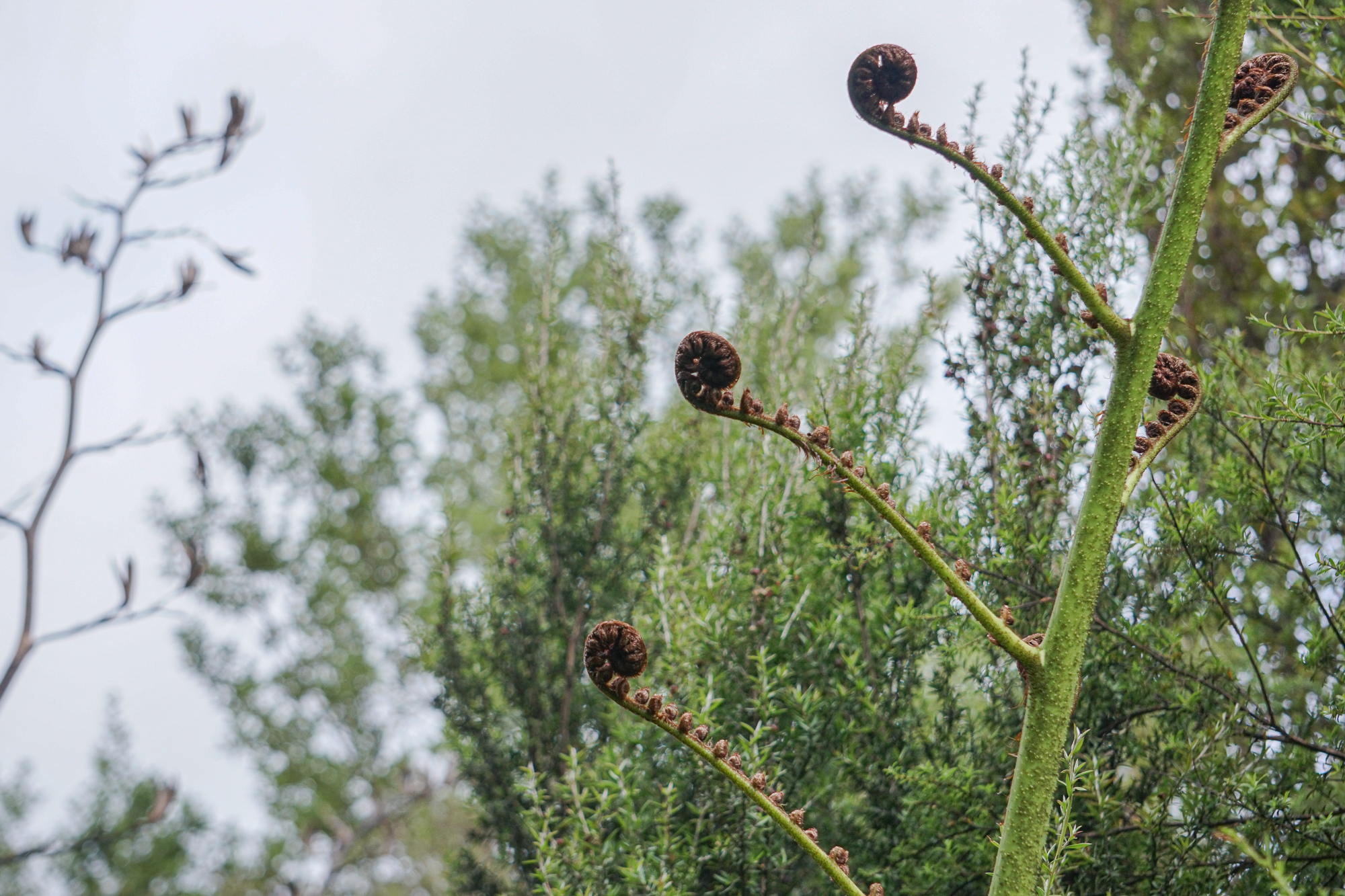
Mamaku or “Black Tree Fern” (Cyathea medullaris)
Young Fronds
The Mamaku or “Black Tree Fern'' is a large tree fern that grows across the South-Pacific. It’s thin black trunk is cast with a subtle pattern and covered in a furry, hairy plant material that causes an itchy irritation if it comes in contact with skin. In ideal growing conditions, mamaku will grow to 20m tall with fronds reaching 5m in length. It has palm-tree- like foliage with fronds that unravel from the top of its trunk and grow outward into an umbrella-like shape. It’s not edible, but Māori use the fronds and foliage for medicinal treatments. As for the slimy innards of the black tree fern frond, Charlie Dunn said, “My grandfather and all the old people used to take that off and clean it and split it and scrap all of the inside off. They used to use that for burns and boils and scabs and whatever to do with skin problems. It’s really slimy, really yucky slimy stuff. They used to use that for boils. We didn’t have antibiotics like we have now to cure all those sores up, that's what they used to use the inside of the frond. Scrap all that stuff out, really slimy and put that on you and wrap you up. For all of your skin problems.”
Murdoch Riley’s book Māori Healing Remedies: Rongoā Māori offers one treatment that utilizes the Young Fronds of mamaku. See: Sore Eyes (61).31 Riley, 61.

Leaves
Although slower to mature than mamaku, the tall, slender trunk of the Ponga or “Silver Tree Fern” can grow up to 10m high, with individual fronds growing up to 4m in length. The underside of the fronds take on a silvery appearance when the plant approaches four years-old. Māori would place the fern silver side up along forest trails to light their path at night because it reflected the moonlight. They would also place ferns on their floors to make soft mats, always silver side down to avoid contact between skin and the underside of the fern, which has spores that cause skin irritation. The ponga has become a national symbol for New Zealand. It appears on company logos and advertisements across the country for national sports teams, dairy products and airlines. Like the kiwi bird, the silver fern is an unofficial national emblem.
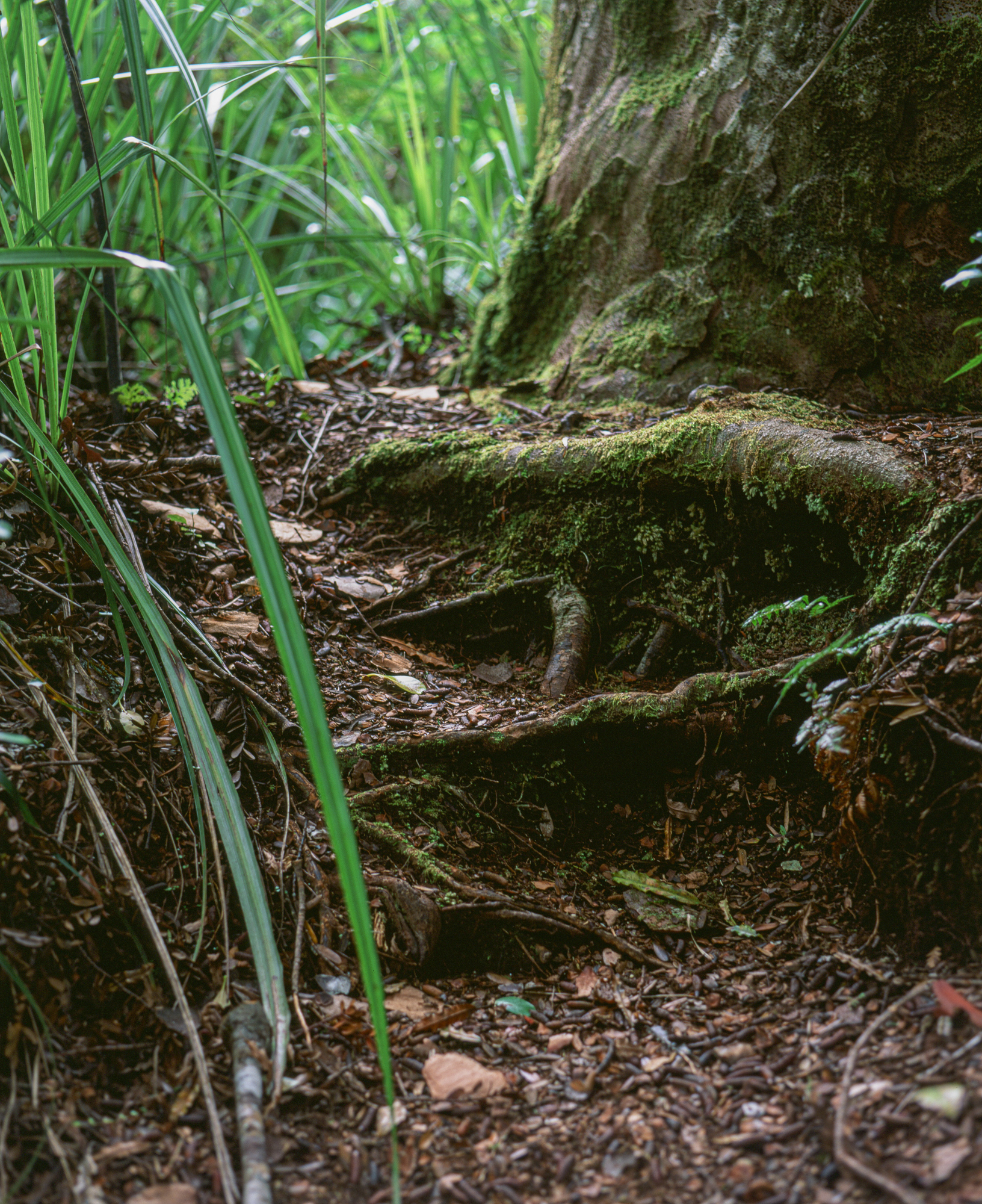
Kauri grass is a slow-growing perennial plant native to New Zealand. It is commonly found in kauri forests and often grows at or around the base of kauri trees, protecting their fragile root system. It is an ever-present guard of the great kauri giants that stand today and of the persistent kauri rickers (kauri in the immature growth phase), so that they may grow into the giants of the future.